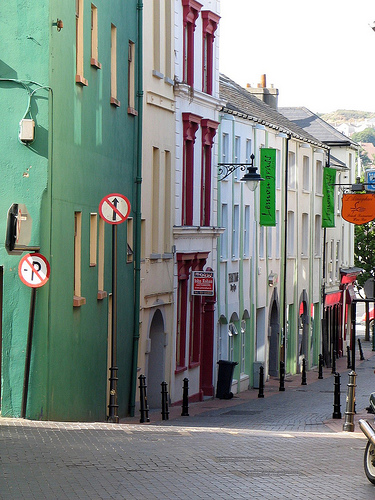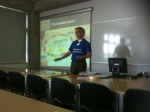I was invited to speak at the inaugural Irish Symposium on Game-Based Learning by a colleague who has long shared my interest of games use in education, Patrick Felicia. Held in Waterford, Ireland, by the Institute of Technology’s Game-based Learning research group, the symposium aimed to generate discussion and forward planning around existing research and practice in the area.
Getting to Waterford was an interesting game in itself, myself and fellow speaker Nicola Whitton travelling the opposite way out to the eastern coast of Essex, for the daily flight from London Southend to Waterford. However, safely arriving in the Viking hotel (complete with Asgard bar) after a rather beautiful flight over lamp-lit coastal villages, we were prepared for the following action-packed day.
An opening keynote from Michael Hallissy of Dublin’s Digital Hub set the tone of the event, with tales of ambitious games-design projects for young adults which led to further questions about the roles of technology, pedagogic design, and the benefits and pitfalls of games-based approaches. The symposium then split into two streams, allowing participants to cross streams after each paper via changeover periods (a good model which many other conferences could take note of).
The range of papers in the two streams was impressive in both breadth and depth. In the space of an hour, I heard a fascinating and detailed physiological discussion of the use of ‘sonic spaces’ to enhance student immersion and engagement from performer and researcher Flaithri Neff of Limerick Institute of Technology; and a case study in the use of a simple board game to introduce key concepts in genetics teaching to students and younger learners. The board game, presented by Eoin Gill of Waterford IoT, was produced as part of a European 2Ways funded project with the GENIE CETL centre at the University of Leicester (and, embarrassingly, was the first I’d heard of it, but I shall be off to see them this week!); and it was an excellent example of the use of a simple game to quickly set a complex context, through the use of simple targetted elements: players receive an alien body and a pen, and move around the board adding random mutations to their body whilst watching their population grow and shrink.
The board game formed an excellent case study for my own paper, which centred around the use of simple games or game-based elements to set up authentic contexts – following up my earlier work (see Moseley, 2010 in publications) and focussing on their use in course design and delivery.
A few research postgraduates presented their work, which added some fresh and detailed studies to the mix – Karen Orr, graduating from Queen’s University Belfast, provided one of the most interesting with her psychometric tests and scale to determine people’s attitude to games use in education. She determined three factors: benefits (perceived usefulness), self-efficacy (not wanting to look stupid), and boastfulness/confidence (in own ability to play and learn from games). It will be interesting to see papers which result from this thesis in due course.
Patrick Felicia followed this with his own initial analysis of data gathered from a survey of Irish educators in Higher Education, on the use and attitudes to games-based learning in the classroom. There were some interesting early outcomes, including a lack of difference by gender, and a dip in effectiveness if games-based approaches are over-used.
Ryan Flynn, lecturer in games design at the University of Greenwich, presented a fascinating paper on the development of a ‘realistic’ simulation for Social Work training, and the decisions taken about levels of realism and immersion appropriate to the project. Ryan is developing a R.E.A.L. framework which considers the various factors influencing the level of realism required for any application – one to keep tabs on as it develops.
The day finished with an extremely positive round-table discussion about consolidating expertise and moving the games-based-learning agenda forward in Ireland. Some real strides were made through discussion in the room, and we could certainly do with these levels of energy and positive action in England.
Packed around these highlights were some interesting discussions over coffee and home-made cakes, demonstrations of games-based applications by IoT Masters students, and (to finish off the day perfectly) a fabulous meal in a cosy restaurant in Waterford centre. All in all, a fascinating, friendly and energising symposium – congratulations to Patrick and Waterford.


